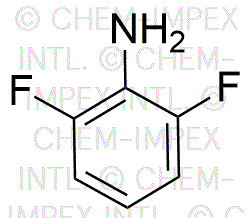2,6-Difluoroaniline is widely utilized in research focused on:
- Pharmaceutical Development: This compound serves as a key intermediate in the synthesis of various pharmaceuticals, particularly in the creation of anti-inflammatory and analgesic drugs. Its unique fluorine substitutions can enhance biological activity and selectivity.
- Agricultural Chemicals: It is used in the formulation of agrochemicals, including herbicides and fungicides. The fluorine atoms improve the efficacy and stability of these compounds, making them more effective in pest control.
- Dyes and Pigments: 2,6-Difluoroaniline is employed in the production of dyes, contributing to vibrant colors in textiles and coatings. Its chemical properties allow for better lightfastness and durability compared to other anilines.
- Polymer Additives: This chemical is incorporated into polymers to enhance their thermal and chemical resistance. Industries such as automotive and electronics benefit from materials that can withstand harsh environments.
- Research and Analytical Chemistry: It is utilized as a reagent in various chemical reactions and analytical techniques, aiding researchers in the development of new materials and the analysis of complex mixtures.
General Information
Properties
Safety and Regulations
Applications
2,6-Difluoroaniline is widely utilized in research focused on:
- Pharmaceutical Development: This compound serves as a key intermediate in the synthesis of various pharmaceuticals, particularly in the creation of anti-inflammatory and analgesic drugs. Its unique fluorine substitutions can enhance biological activity and selectivity.
- Agricultural Chemicals: It is used in the formulation of agrochemicals, including herbicides and fungicides. The fluorine atoms improve the efficacy and stability of these compounds, making them more effective in pest control.
- Dyes and Pigments: 2,6-Difluoroaniline is employed in the production of dyes, contributing to vibrant colors in textiles and coatings. Its chemical properties allow for better lightfastness and durability compared to other anilines.
- Polymer Additives: This chemical is incorporated into polymers to enhance their thermal and chemical resistance. Industries such as automotive and electronics benefit from materials that can withstand harsh environments.
- Research and Analytical Chemistry: It is utilized as a reagent in various chemical reactions and analytical techniques, aiding researchers in the development of new materials and the analysis of complex mixtures.
Documents
Safety Data Sheets (SDS)
The SDS provides comprehensive safety information on handling, storage, and disposal of the product.
Product Specification (PS)
The PS provides a comprehensive breakdown of the product’s properties, including chemical composition, physical state, purity, and storage requirements. It also details acceptable quality ranges and the product's intended applications.
Certificates of Analysis (COA)
Search for Certificates of Analysis (COA) by entering the products Lot Number. Lot and Batch Numbers can be found on a product’s label following the words ‘Lot’ or ‘Batch’.
Número de catálogo
Número de lote/lote
Certificates Of Origin (COO)
This COO confirms the country where the product was manufactured, and also details the materials and components used in it and whether it is derived from natural, synthetic, or other specific sources. This certificate may be required for customs, trade, and regulatory compliance.
Número de catálogo
Número de lote/lote
Safety Data Sheets (SDS)
The SDS provides comprehensive safety information on handling, storage, and disposal of the product.
DownloadProduct Specification (PS)
The PS provides a comprehensive breakdown of the product’s properties, including chemical composition, physical state, purity, and storage requirements. It also details acceptable quality ranges and the product's intended applications.
DownloadCertificates of Analysis (COA)
Search for Certificates of Analysis (COA) by entering the products Lot Number. Lot and Batch Numbers can be found on a product’s label following the words ‘Lot’ or ‘Batch’.
Número de catálogo
Número de lote/lote
Certificates Of Origin (COO)
This COO confirms the country where the product was manufactured, and also details the materials and components used in it and whether it is derived from natural, synthetic, or other specific sources. This certificate may be required for customs, trade, and regulatory compliance.


